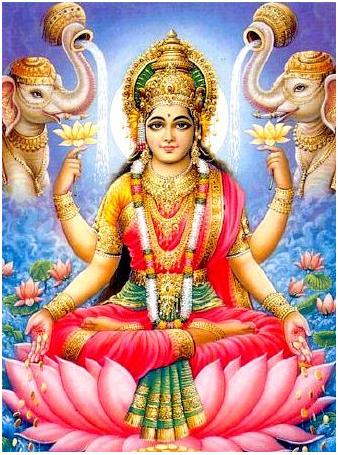Mahalakshmi – Venupayyanur
Mahalakshmi is the Goddess of Wealth, health and prosperity and is the consort of Lord Vishnu, the God of Preservation. Lakshmi is depicted as a beautiful woman of golden complexion, with four hands, sitting or standing on a full-bloomed lotus and holding lotus buds and bestowing gold coins of prosperity to all her worshippers, symbolic of when the lotus of wisdom blossoms, the wealth of good and noble qualities appears and Lakshmi’s blessings will be present. Two elephants are often shown standing next to the goddess and spraying water. This denotes that ceaseless effort, in accordance with one’s dharma and governed by wisdom and purity, leads to both material and spiritual prosperity. Elephants also signify her royal power. Lotus is associated with many of the Hindu Gods and Goddess and in relation to Shri-Lakshmi this refers to purity and spiritual power. Rooted in the mud, but blossoming above the water, completely uncontaminated by the mud, the lotus represents spiritual perfection and authority which rises above worldly contamination.
The word ‘Lakshmi’ is derived from the Sanskrit word “Laksya”, meaning ‘aim’ or ‘goal’ and for most people in this world, their only aim is to amass wealth. But one can amass wealth by different means, as Lord Kubera, the God of wealth can bless you, as well as all other gods and demi-gods. Wealth can also be given by Rakshasa, Gandharva, kinnara, kimpurusha, etc. So what makes Lakshmi so different from others? Mother Lakshmi is the One who bestows 16 types of wealth:(1) Fame; (2) Knowledge; (3) Courage and Strength; (4) Victory; (5) Good Children; (6) Valor; (7) Gold, Gems and Other Valuables; (8) Grains in abundance; (9) Happiness; (10) Bliss; (11) Intelligence; (12) Beauty; (13) Higher Aim, High Thinking and Higher Meditation; (14) Morality and Ethics; (15) Good Health; (16) Long Life. Have you heard of Ashtalakshmi?
- Adi Lakshmi : an ancient form of Lakshmi and incarnation of Lakshmi as daughter of sage Bhrigu
- Dhana Lakshmi: for money and gold
- Dhanya Lakshmi : Giver of agricultural wealth.
- Gaja Lakshmi : Giver of animal wealth like cattle and
- Santana Lakshmi : Bestower of offspring
- Veera Lakshmi : Bestower of valour in battles and courage and strength for overcoming difficulties in life.
- Vijaya Lakshmi : Giver of victory, not only in battles but also over conquering hurdles in order to beget success.
- Vidya Lakshmi : the bestower of knowledge of arts and sciences
People who amass wealth through dubious means, corruption, etc is actually not blessed by Mata Lakshmi as they will not be bestowed with all the 16 wealth including peace of mind. So how can one get the blessings of Mahalakshmi? As mentioned earlier, it is already shown in her iconography, lotus and Elephant. Be unattached; do not be influenced by your surroundings and keep on working hard, all will get the blessings of Goddess Lakshmi.
The Vahana of Lakshmi is an Owl called Uluka. Owl is looked upon as a bird of ill omen, a symbol of darkness, disgrace and misfortune. The bird is blind during day time and sleeps the whole day but very active at night and has vision too. It rarely trust human beings and seldom seen in the company of any other bird. This reflects that people are generally blinded by wealth. They forget the good aspect of riches such as proper use and charity and become even greedier and destroy themselves with their own wealth. Such people may also not get peaceful sleep during the night and may end up sick and restless. Those who pursue riches should be aware of these negative qualities and pray to Shri Mahalakshmi so that she would inculcate in them the qualities of trust, generosity and social responsibility and would make them popular among people. She would also help them come out of the darkness of ignorance, avarice and selfishness, which are generally associated with the pursuit of materialism.



